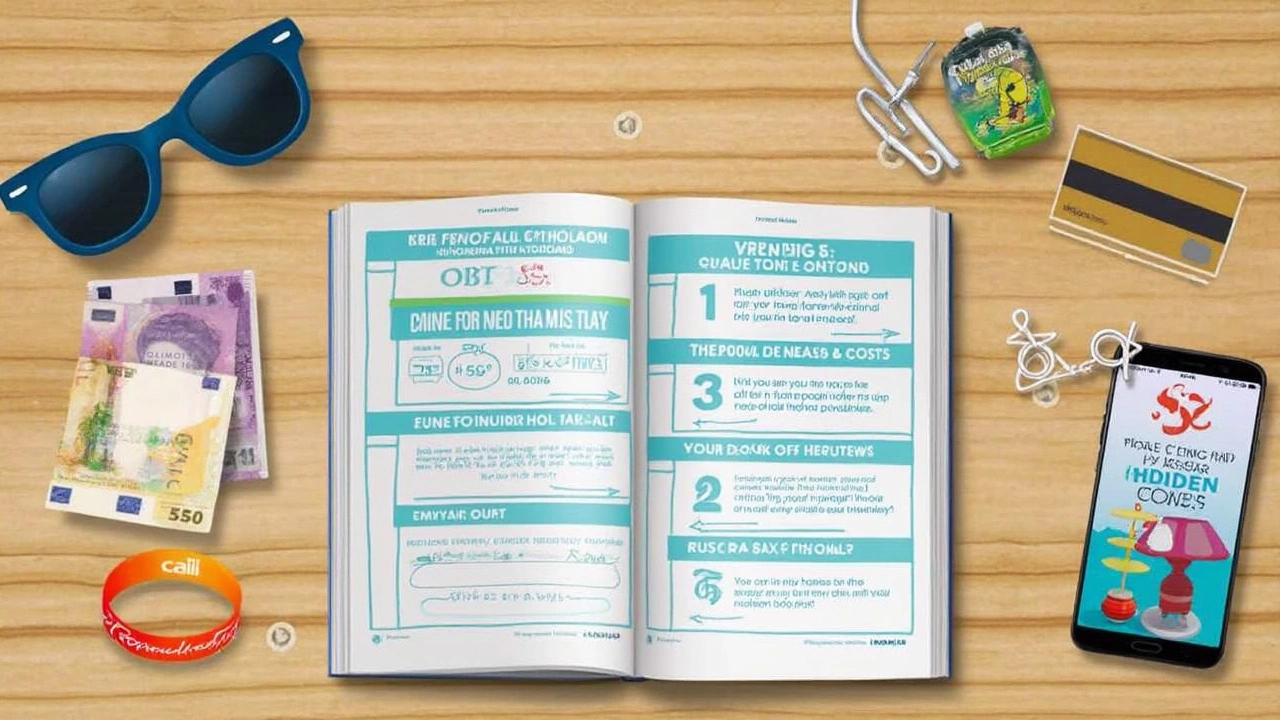Do I Need Spending Money for All-Inclusive? The Real Costs Explained
 Apr, 21 2025
Apr, 21 2025
So you’ve spotted a dreamy all-inclusive deal and you’re wondering if you can finally leave your wallet behind. Sounds perfect, right? Well, not quite. Even at a resort where 'everything’s included,' there are still a few sneaky ways your money can disappear.
Here’s the truth—'all-inclusive' usually means your room, meals, drinks, some activities, and maybe a bit of entertainment are wrapped up in the price. But not every cocktail, dinner, or little indulgence is part of that package. A lot depends on the resort and country. Some places serve local drinks for free and then charge extra if you want branded spirits. Plus, off-site excursions, spa treatments, and shops aren’t usually free.
Don’t get caught off guard. Knowing exactly what’s covered from the start will save you from post-checkout panic. Think of this guide as your quick cheat sheet to decide exactly how much (if any!) spending money you really need for your all-inclusive holiday.
- What All-Inclusive Really Covers
- Hidden Extras You Might Not Expect
- When and Where You'll Want Extra Cash
- Smart Tips to Make Your Money Go Further
What All-Inclusive Really Covers
Here’s the truth: not every place means the same thing by all-inclusive. Most of the time, it means you’re sorted for the basics—your room, a bunch of buffet meals, snacks, soft drinks, and local alcohol. Big bonus for families: kids’ clubs and basic water activities (like paddle boards or kayaks) are usually on the house. But don’t just assume everything is free because you booked an all-in deal. Let’s break down what gets covered at most places—no guessing, no surprises.
- Rooms: You get the accommodation you booked, but some room types or upgrades will still cost extra. Want a sea view or a private pool? Those usually hike up the bill.
- Meals: Main buffet meals are the staple. Some spots throw in a few à la carte restaurants, but you might need to reserve or stick to a certain number of visits.
- Drinks: Local beers, soft drinks, and basic spirits are included in most packages. If you’re craving branded drinks—or fancy cocktails—you’ll likely pay more.
- Snacks: Mid-day and late-night snacks are often free, like pizza, burgers, or fruit near the pool.
- Entertainment and activities: Evening shows, local performances, and resort games are part of the deal. Watersports without motors, like canoeing or snorkeling, usually don’t cost extra. But jet skis? Those aren’t free.
Some resorts are getting fancier with what’s included, but don’t expect freebies for every little thing. For example, a Sandals resort in the Caribbean might include unlimited scuba diving, but a family resort in Spain probably won’t.
| Included | Usually Not Included |
|---|---|
| Buffet meals | Room upgrades |
| Local drinks | Premium alcohol |
| Basic water sports | Motorized activities |
| Evening shows | Spa treatments |
| Snacks | Off-site excursions |
All this means: double check what’s actually included at all-inclusive resorts before you leave. Each place spells out what you get on their website or booking form. Skip the mystery and read the fine print—your wallet will thank you.
Hidden Extras You Might Not Expect
Thinking you’ve got it all sorted with your all-inclusive deal? Don’t get too comfortable. Resorts are getting creative with what they charge for, and it’s easy to get caught off guard. Here’s what often slips through the “included” net.
- Premium Drinks: The free rum and cola is probably local, not your favorite brand. If you want a certain imported gin or a fancy wine, expect an extra charge—sometimes up to $10 per glass. Some resorts have "exclusive" bars or menus with prices not covered by your package.
- Specialty Restaurants: While the main buffet and basic restaurants are usually part of the deal, themed or à la carte spots often need reservations and may slap on a cover charge or limit how many times you can dine there for free. Extra visits? That’s coming out of your pocket.
- Spa and Wellness: Massages, facials, or even yoga classes at resorts aren’t free. A basic massage can run $60-$120, depending where you are. Even simple beauty treatments rack up fast.
- Off-site Excursions: Think boat trips, guided tours, scuba diving, or zip-lining. These are never included, and prices can be steep. An average half-day boat trip might be $50-$80 per person, sometimes more if you’re in places like the Maldives or Mexico.
- Kid’s Club Extras: While the basic babysitting or playrooms might be included, special activities, excursions, or after-hours care are almost always extra.
- Room Upgrades and Mini-Bar: The room fridge might look inviting, but most snacks and drinks in there cost extra. Ocean views, larger rooms, or suites also almost always have a surcharge.
- Resort Fees & Taxes: Some countries or cities—like the Dominican Republic or Cancun—now add their own tourist taxes. Resort fees can be $5-$20 per night, per room, and aren’t always clear upfront.
To put it in perspective, here’s a sample of what extras might cost at a mid-range all-inclusive resort:
| Item | Estimated Cost (USD) |
|---|---|
| Premium cocktail | 8 |
| Spa massage (1 hour) | 90 |
| Off-site excursion | 75 |
| Extra a la carte dinner | 30 |
| Mini-bar snacks | 5 each |
The trick? Always check the fine print before your trip. If you’re someone who likes upgrades, daily fancy coffees, or exploring outside the resort, you’ll definitely need some spending money on hand. It beats racking up an unplanned bill at checkout.

When and Where You'll Want Extra Cash
Even the best all-inclusive holidays have gaps in coverage. You’ll definitely run into things that just aren’t part of the package. Knowing ahead of time saves frustration (and surprise bills).
The most common places you'll reach for your wallet are:
- Excursions and Tours: Most all-inclusive deals skip any trips that take you off the resort, like snorkel tours, boat rides, or city visits. These add-ons are never cheap. Typically, day trips start around $40 per adult and go way up depending on the location.
- Spa Treatments: Massages, facials, manicures—all these feel like the ultimate treat, but resorts almost always charge extra for the spa. Think $60 to $150 per treatment, even at mid-range places.
- Specialty Dining: Sure, buffet meals are included, but if you want to splurge on the steakhouse or book a romantic beach dinner, you’ll generally pay a fee (often $10–$25 per person, sometimes more).
- Premium Drinks: Local beer and basic cocktails are free, but international wine, champagne, or top-shelf spirits? They’re rarely on the house.
- SOUVENIRS & SHOPS: Gift shops, boutiques, and even sundry stands are never in the all-inclusive price. T-shirts, snacks, sunblock—they all cost extra.
- Tips/Gratuities: Even if tipping is technically included, staff usually appreciate small cash tips, and you’ll notice better service. In places like Mexico and the Caribbean, a dollar or two per drink or meal goes a long way.
| Extra Cost | Typical Price (USD) |
|---|---|
| Snorkel Excursion | $40–$120 |
| Spa Treatment | $60–$150 |
| Specialty Restaurant | $10–$40 per person |
| Branded Cocktails | $5–$15 per drink |
| Souvenir T-shirt | $10–$25 |
It also pays to have local currency for small shops, taxis, or tips, especially if you’re outside the eurozone or traveling to places where card payments aren’t always possible (think Dominican Republic, Jamaica, or remote parts of Greece). ATMs at resorts can charge hefty fees or run out of cash on busy weeks.
If you’re into water sports, like jet-skiing or parasailing, those usually aren’t in your all-inclusive package either. Double-check what’s included with your stay so there aren't surprises. A quick email before you go can clear up what you need to budget for.
Smart Tips to Make Your Money Go Further
Nobody wants to run out of cash halfway through their all-inclusive break. Let’s get practical on keeping your holiday budget tight—without missing out on any fun.
- Check what’s actually included in your package before you go. Sometimes, you’ll find that premium drinks, à la carte dinners, and water sports come with an extra fee at even the fanciest resorts. Hit up the resort’s website or ask your travel agent for details. Print it or keep the info on your phone so you don’t get caught off guard.
- Bring some local cash for tips. While tipping isn’t always expected at all-inclusive spots, a couple of euros or dollars are always welcome—and can get you faster service or a well-made drink. Most travelers set aside about $5 to $10 per day for tips.
- Book activities before you travel. Love scuba or planning day trips off the resort? Book these in advance. It’s usually cheaper online and you can avoid overpriced 'special offers' at the concierge desk.
- Watch your extras at the spa, minibar, or resort shop. Even a simple snack or souvenir can cost triple what you’d pay in town. Need a souvenir? Walk ten minutes to a shop outside the gates.
- Stick with house drinks and buffet meals when possible. Upgraded cocktails or steakhouse dinners look tempting, but they add up fast. Free does taste better, trust me.
According to a 2024 survey by Booking.com, the average all-inclusive traveler spends just under $200 extra per week on off-package treats, mostly spa sessions and local excursions. Here’s a handy look at where spending money often goes:
| Extra Cost | Typical Price Range (per item) |
|---|---|
| Spa Treatment | $40 - $120 |
| Off-Site Excursion | $35 - $80 |
| Souvenirs | $5 - $30 |
| Branded Alcohol | $4 - $12 per drink |
Don’t forget about ATM fees, either. International withdrawals can hit you with $3-6 per transaction, plus whatever your bank charges. If you want to go all digital, see if your resort accepts popular payment apps like Apple Pay or Google Pay. But pack some small bills anyway, just in case.
"Always double-check what’s included in your all-inclusive package before your trip. It’s the simplest way to dodge those unexpected add-ons." – Lonely Planet Travel Guide, 2024
With a bit of planning and smart choices, your holiday budget stretches way further. And honestly, saving a few bucks here means you can splurge a little more on what really matters—like that unforgettable sunset dinner or a massage by the beach.
